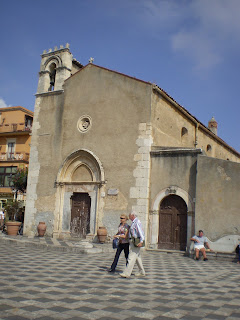Sicily is a land of legends: the Messina strait at the North of the island is where Ulysses had to face Scylla and Charybdis; the Jonian Sea would be where he heard the Mermaids and the coast Between Acireale and Catania is identified as the Coast of the Cyclops. The Etna vulcano was known as Hephestos' forge and the central plain of the island, around the town of Enna, was the place where Persephone went to pick flowers before Hades kidnapped her.
But Sicily has also a real story, dating back to 5000 years ago: Phoenicians, Greeks, Romans. Arabs, Normans, French, Spaniards ruled over the island until it was united to Italy by Garibaldi. All these people left their traces and influenced the traditions.
Fortunately, nowadays there are no more invasions, except that there are lots of tourists coming from everywhere to enjoy the sun, the beautiful landscapes, the good food and the good wine.
It's a pity I wasn't there on vacation, but to attend a scientific meeting... However, I could go a bit around and enjoy it.
Monday, October 20, 2008
Capo San't Alessio
Actually, I wasn't in Taormina, but in Sant'Alessio Siculo, a small village by the sea.

Capo San't Alessio, as seen from the village
The ancient castle of Capo Sant' Alessio : this castle was built by Arabs and conquered by the Normans. They say that Emperor Alex I of Bizance stayed there when he visited Sicily, as well as Emperor Charles V of Germany.
Taormina, seen from the village
The village seen from Capo Sant'Alessio
Some pics of San't Alessio
This is the villa Genovese, a 19th. century building, hosting a very small museum with a few amphores and ojects found under the sea.
The church.
The church's garden.
In spite of being a small village, Sant'Alessio has a long history. In the surroundings there was a battle of the forces of Octavius (later known as Augustus) against the army of Pompeius, in 36 b.C. It is also said that the name of the village was chosen to honour the saint of Emperor Alex I of Bizance, who visited this place in 1000 a.C.
The Greek amphitheatre of Taormina
Around Taormina
It is full of antiquaries, fashion boutiques selling top brands clothes, shoes and bags.
IX November square
Subscribe to:
Comments (Atom)






















